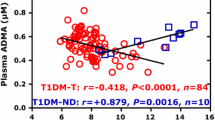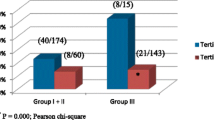Abstract
Asymmetric dimethylarginine (ADMA) systemic concentrations are elevated in hypercholesterolemic adults and contribute to nitric oxide (NO) dependent endothelial dysfunction. Decreased activity of the key ADMA-hydrolyzing enzyme dimethylarginine dimethylaminohydrolase (DDAH) may be involved. Yet, the ADMA/DDAH/NO pathway has not been investigated in childhood hypercholesterolemia. We studied 64 children with hypercholesterolemia type II (HCh-II) and 54 normocholesterolemic (NCh) children (mean ± SD; age, years: 11.1 ± 3.5 vs. 11.9 ± 4.6). Plasma and urine ADMA was measured by GC–MS/MS. Dimethylamine (DMA), the ADMA metabolite, creatinine, nitrite and nitrate in urine were measured by GC–MS. The DMA/ADMA molar ratio in urine was calculated to estimate whole body DDAH activity. ADMA plasma concentration (mean ± SD; nM: 571 ± 85 vs. 542 ± 110, P = 0.17) and ADMA urinary excretion rate (mean ± SD: 7.1 ± 2 versus 7.2 ± 3 μmol/mmol creatinine, P = 0.6) were similar in HCh-II and NCh children. Both DMA excretion rate [median (25th–75th percentile): 56.3 (46.4–109.1) vs. 45.2 (22.2–65.5) μmol/mmol creatinine, P = 0.0004] and DMA/ADMA molar ratio [median (25th–75th percentile): 9.2 (6.0–16.3) vs. 5.4 (3.8–9.4), P = 0.0004] were slightly but statistically significantly increased in HCh-II children compared to NCh children. Plasma and urinary nitrite and nitrate were similar in both groups. In HCh-II whole body DDAH activity is elevated as compared to NCh. HCh-II children treated with drugs for hypercholesterolemia had lower plasma ADMA levels than untreated HCh-II or NCh children, presumably via increased DDAH activity. Differences between treated and untreated HCh-II children were not due to differences in age. In conclusion, HCh-II children do not have elevated ADMA plasma levels, largely due to an apparent increase in DDAH activity. While this would tend to limit development of endothelial dysfunction, it is not clear whether this might be medication-induced or represent a primary change in HCh-II children.

Similar content being viewed by others
References
Becker T, Mevius I, de Vries DK, Schaaherder AFM, Meyer zu Vilsendorf A, Klempnauer J, Frölich JC, Tsikas D (2009) The l-arginine/NO pathway in end-stage liver disease and during orthotopic liver and kidney transplantation: biological and analytical ramifications. Nitric Oxide 20:61–67
Böger RH, Bode-Böger SM, Szuba A, Tsao PS, Chan JR, Tangphao O, Blaschke TF, Cooke JP (1998) Asymmetric dimethylarginine (ADMA): a novel risk factor for endothelial dysfunction: its role in hypercholesterolemia. Circulation 98:1842–1847
Böger RH, Sydow K, Borlak J, Thum T, Lenzen H, Schubert B, Tsikas D, Bode-Böger SM (2000) LDL cholesterol upregulates synthesis of asymmetrical dimethylarginine in human endothelial cells: involvement of S-adenosylmethionine-dependent methyltransferases. Circ Res 87:99–105
Brooks ER, Langman CB, Wang S, Price HE, Hodges AL, Darling L, Yang AZ, Smith FA (2009) Methylated arginine derivatives in children and adolescents with chronic kidney disease. Pediatr Nephrol 24:129–134
Eid HM, Eritsland J, Larsen J, Arnesen H, Seljeflot I (2003) Increased levels of asymmetric dimethylarginine in populations at risk for atherosclerotic disease. Effects of pravastatin. Atherosclerosis 166:279–284
Gladwin MT, Schechter AN, Kim-Shapiro DB, Patel RP, Hogg N, Shiva S, Cannon RO 3rd, Kelm M, Wink DA, Espey MG, Oldfield EH, Pluta RM, Freeman BA, Lancaster JR Jr, Feelisch M, Lundberg JO (2005) The emerging biology of the nitrite anion. Nat Chem Biol 1:308–314
Goonasekera CDA, Rees DD, Woolard P, Frend A, Shah V, Dillon MJ (1997) Nitric oxide synthase inhibitors and hypertension in children and adolescents. J Hypertens 15:901–909
Horowitz JD, Heresztyn T (2007) An overview of plasma concentrations of asymmetric dimethylarginine (ADMA) in health and disease and in clinical studies. J Chromatogr B 851:42–50
Ito A, Tsao PS, Adimoolam S, Kimoto M, Ogawa T, Cooke JP (1999) Novel mechanism for endothelial dysfunction: dysregulation of dimethylarginine dimethylaminohydrolase. Circulation 99:3092–3095
Jehlicka P, Stozicky F, Mayer OJR, Varvarovska J, Racek J, Trefil L, Siala K (2009) Asymmetric dimethylarginine an the effect of folat substitution in children with familial hypercholesterolemia and diabetes mellitus type 1. Physiol Res 58:179–184
Kanzelmeyer N, Tsikas D, Chobanyan-Jürgens K, Beckmann B, Vaske B, Illsinger S, Das AM, Lücke T (2011) Asymmetric dimethylarginine in children with homocystinuria or phenylketonuria. Amino Acids. doi:10.1007/s00726-011-0892
Leiper JM, Vallance P (2006) The synthesis and metabolism of asymmetric dimethylarginine (ADMA). Eur J Clin Pharmacol 62:33–38
Lu TM, Ding YA, Leu HB, Yin WH, Sheu WH, Chu KM (2004) Effect of rosuvastatin on plasma levels of asymmetric dimethylarginine in patients with hypercholesterolemia. Am J Cardiol 94:157–161
Lücke T, Tsikas D, Kanzelmeyer N, Vaske B, Das AM (2006) Elevated plasma concentrations of the endogenous nitric oxide synthase inhibitor asymmetric dimethylarginine in citrullinemia. Metabolism 55:1599–1603
Lücke T, Kanzelmeyer N, Kemper MJ, Tsikas D, Das AM (2007) Developmental changes in the l-arginine/nitric oxide pathway from infancy to adulthood: plasma asymmetric dimethylarginine levels decrease with age. Clin Chem Lab Med 45:1525–1530
Lücke T, Kanzelmeyer N, Chobanyan K, Tsikas D, Franke D, Kemper MJ, Ehrich JH, Das AM (2008) Elevated asymmetric dimethylarginine (ADMA) and inverse correlation between circulating ADMA and glomerular filtration rate in children with sporadic focal segmental glomerulosclerosis (FSGS). Nephrol Dial Transplant 23:734–740
Nakamura T, Sato E, Fujiwara N, Kawagoe Y, Ueda Y, Suzuki T, Ueda S, Adachi H, Okuda S, Yamagishi S (2009) Ezetimibe decreases serum levels of asymmetric dimethylarginine (ADMA) and ameliorates renal injury in non-diabetic chronic kidney disease patients in a cholesterol-independent manner. Pharmacol Res 60:525–528
Nanayakkara PW, Kiefte-de Jong JC, ter Wee PM, Stehouwer CD, van Ittersum FJ, Olthof MR, Teerlink T, Twisk JW, van Guldener C, Smulders YM (2009) Randomized placebo-controlled trial assessing a treatment strategy consisting of pravastatin, vitamin E, and homocysteine lowering on plasma asymmetric dimethylarginine concentration in mild to moderate CKD. Am J Kidney Dis 53:41–50
Oguz A, Uzunlulu M (2008) Short term fluvastatin treatment lowers serum asymmetric dimethylarginine levels in patients with metabolic syndrome. Int Heart J 49:303–311
Palm M, Onozato ML, Luo Z, Wilcox CS (2007) Dimethylarginine dimethylaminohydrolase (DDAH): expression, regulation and function in the cardiovascular and renal systems. Am J Physiol Heart Circ Physiol 293:3227–3245
Surdacki A, Tsikas D, Mayatepek E, Frölich JC (2003) Elevated urinary excretion of nitric oxide metabolites in young infants with Zellweger syndrome. Clin Chim Acta 334:111–115
Tan B, Jiang DJ, Huang H, Jia SJ, Jiang JL, Hu CP, Li YJ (2007) Taurine protects against low-density lipoprotein-induced endothelial dysfunction by the DDAH/ADMA pathway. Vascul Pharmacol 46:338–345
Tsikas D (2000) Simultaneous derivatization and quantification of the nitric oxide metabolites nitrite and nitrate in biological fluids by gas-chromatography/mass spectrometry. Anal Chem 72:4064–4072
Tsikas D (2008a) A critical review and discussion of analytical methods in the l-arginine/nitric oxide (NO) area of basic and clinical research. Anal Biochem 379:139–163
Tsikas D (2008b) Determination of asymmetric dimethylarginine (ADMA) in biological fluids: a paradigm for a successful analytical story. Curr Opin Clin Nutr Metab Care 11:592–600
Tsikas D, Schubert B, Gutzki FM, Sandmann J, Frölich JC (2003) Quantitative determination of circulating and urinary asymmetric dimethylarginine (ADMA) in humans by gas chromatographytandem mass spectrometry as methyl ester tri (N-pentafluoropropionyl) derivative. J Chromatogr B 798:87–99
Tsikas D, Thum T, Becker T, Pham VV, Chobanyan K, Mitschke A, Beckmann B, Gutzki FM, Bauersachs J, Stichtenoth DO (2007) Accurate quantification of dimethylamine (DMA) in human urine by gas chromatography-mass spectrometry as pentafluorobenzamide derivative: evaluation of the relationship between DMA and its precursor asymmetric dimethylarginine (ADMA) in health and disease. J Chromatogr B 851:229–239
Tsikas D, Schwarz A, Stichtenoth DO (2010) Simultaneous measurement of [15N]nitrate and [15N]nitrite enrichment and concentration in urine by gas chromatography mass spectrometry as pentafluorobenzyl derivatives. Anal Chem 82:2585–2587
Wolf C, Lorenzen JM, Stein S, Tsikas D, Störk S, Weidemann F, Ertl G, Anker S, Bauersachs J, Thum T (2011) Urinary asymmetric dimethylarginine (ADMA) is a predictor of mortality risk in patients with coronary artery disease. Int J Cardiol. doi:10.1016/j.ijcard.2010.11.003
Wu G (2009) Amino acids: metabolism, functions, and nutrition. Amino Acids 37:1–17
Wu G, Bazer FW, Davis TA, Kim SW, Li P, Rhoads JM, Satterfield MC, Smith SB, Spencer TE, Yin YL (2009) Arginine metabolism and nutrition in growth, health and disease. Amino Acids 37:153–168
Acknowledgments
The authors thank B. Beckmann and A. Mitschke for excellent laboratory assistance and F.-M. Gutzki for performing GC–MS and GC–MS/MS analyses. We are also thankful to Deutsches Stiftungszentrum (die Stiftung Dr. Edith Grünheit; S150/10028/2010) for the travel support given to KCJ for the presentation of the study results at the 5th International Symposium on ADMA, Chicago/Ill, 2010.
Conflict of interest
The authors declare that they have no conflict of interest.
Author information
Authors and Affiliations
Corresponding author
Rights and permissions
About this article
Cite this article
Chobanyan-Jürgens, K., Fuchs, AJ., Tsikas, D. et al. Increased asymmetric dimethylarginine (ADMA) dimethylaminohydrolase (DDAH) activity in childhood hypercholesterolemia type II. Amino Acids 43, 805–811 (2012). https://doi.org/10.1007/s00726-011-1136-3
Received:
Accepted:
Published:
Issue Date:
DOI: https://doi.org/10.1007/s00726-011-1136-3




